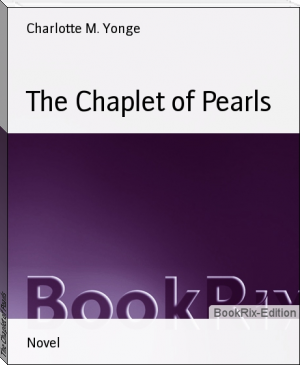The Chaplet of Pearls by Charlotte M. Yonge (i am reading a book .txt) 📕

Read free book «The Chaplet of Pearls by Charlotte M. Yonge (i am reading a book .txt) 📕» - read online or download for free at americanlibrarybooks.com
- Author: Charlotte M. Yonge
Read book online «The Chaplet of Pearls by Charlotte M. Yonge (i am reading a book .txt) 📕». Author - Charlotte M. Yonge
or
THE WHITE AND BLACK RIBAUMONT
CONTENTS
PREFACE
THE CHAPLET OF PEARLS
CHAPTER I. THE BRIDAL OF THE WHITE AND BLACK
CHAPTER II. THE SEPARATION
CHAPTER III. THE FAMILY COUNCIL
CHAPTER IV. TITHONUS
CHAPTER V. THE CONVENT BIRD
CHAPTER VI. FOULLY COZENED
CHAPTER VII. THE QUEEN’S PASTORAL
CHAPTER VIII. ’LE BROUILON’
CHAPTER IX. THE WEDDING WITH CRIMSON FAVOURS
CHAPTER X. MONSIEUR’S BALLET
CHAPTER XI. THE KING’S TRAGEDY
CHAPTER XII. THE PALACE OF SLAUGHTER
CHAPTER XIII. THE BRIDEGROOM’S ARRIVAL
CHAPTER XIV. SWEET HEART
CHAPTER XV. NOTRE-DAME DE BELLAISE*
CHAPTER XVI. THE HEARTHS AND THICKETS OF THE BOCAGE
CHAPTER XVII. THE GHOSTS OF THE TEMPLARS
CHAPTER XVIII. THE MOONBEAM
CHAPTER XIX. LA RUE DES TROIS FEES
CHAPTER XX. THE ABBE
CHAPTER XXI. UNDER THE WALNUT-TREE
CHAPTER XXII. DEPARTURE
CHAPTER XXIII. THE EMPTY CRADLE
CHAPTER XXIV. THE GOOD PRIEST OF NISSARD
CHAPTER XXV. THE VELVET COACH
CHAPTER XXVI. THE CHEVALIER’S EXPIATION
CHAPTER XXVII. THE DYING KING
CHAPTER XXVIII. THE ORPHANS OF LA SABLERIE
CHAPTER XXIX. IN THE KING’S NAME
CHAPTER XXX. CAGED IN THE BLACKBIRD’S NEST
CHAPTER XXXI. THE DARK POOL OF THE FUTURE
CHAPTER XXXII. ’JAM SATIS’
CHAPTER XXXIII. THE SCANDAL OF THE SYNOD OF MONTAUBAN
CHAPTER XXXIV. MADAME LA DUCHESSE
CHAPTER XXXV. THE ITALIAN PEDLAR
CHAPTER XXXVI. SPELL AND POTION
CHAPTER XXXVII. BEATING AGAINST THE BARS
CHAPTER XXXVIII. THE ENEMY IN PRESENCE
CHAPTER XXXIX. THE PEDLAR’S PREDICTION
CHAPTER XL. THE SANDS OF OLONNE
CHAPTER XLI. OUR LADY OF HOPE
CHAPTER XLII. THE SILVER BULLET
CHAPTER XLIII. LE BAISER D’EUSTACIE
CHAPTER XLIV. THE GALIMAFRE
It is the fashion to call every story controversial that deals with times when controversy or a war of religion was raging; but it should be remembered that there are some which only attempt to portray human feelings as affected by the events that such warfare occasioned. ‘Old Mortality’ and ‘Woodstock’ are not controversial tales, and the ‘Chaplet of Pearls’ is so quite as little. It only aims at drawing certain scenes and certain characters as the convulsions of the sixteenth century may have affected them, and is, in fact, like all historical romance, the shaping of the conceptions that the imagination must necessarily form when dwelling upon the records of history. That faculty which might be called the passive fancy, and might almost be described in Portia’s song,—
‘It is engendered in the eyes, By READING fed—and there it dies,’—that faculty, I say, has learnt to feed upon character and incident, and to require that the latter should be effective and exciting. Is it not reasonable to seek for this in the days when such things were not infrequent, and did not imply exceptional wickedness or misfortune in those engaged in them? This seems to me one plea for historical novel, to which I would add the opportunity that it gives for study of the times and delineation of characters. Shakespeare’s Henry IV. and Henry V., Scott’s Louis XI., Manzoni’s Federigo Borromeo, Bulwer’s Harold, James’s Philip Augustus, are all real contributions to our comprehension of the men themselves, by calling the chronicles and memoirs into action. True, the picture cannot be exact, and is sometimes distorted—nay, sometimes praiseworthy efforts at correctness in the detail take away whatever might have been lifelike in the outline. Yet, acknowledging all this, I must still plead for the tales that presumptuously deal with days gone by, as enabling the young to realize history vividly—and, what is still more desirable, requiring an effort of the mind which to read of modern days does not. The details of Millais’ Inquisition or of his Huguenot may be in error in spite of all his study and diligence, but they have brought before us for ever the horrors of the auto-da-fe, and the patient, steadfast heroism of the man who can smile aside his wife’s endeavour to make him tacitly betray his faith to save his life. Surely it is well, by pen as by picture, to go back to the past for figures that will stir the heart like these, even though the details be as incorrect as those of the revolt of Liege or of La Ferrette in ‘Quentin Durward’ and ‘Anne of Geierstein.’
Scott, however, willfully carved history to suit the purposes of his story; and in these days we have come to feel that a story must earn a certain amount of credibility by being in keeping with established facts, even if striking events have to be sacrificed, and that the order of time must be preserved. In Shakespeare’s days, or even in Scott’s, it might have been possible to bring Henry III. and his mignons to due punishment within the limits of a tale beginning with the Massacre of St. Bartholomew; but in 1868 the broad outlines of tragedy must be given up to keep within the bounds of historical verity.
How far this has been done, critics better read than myself must decide. I have endeavoured to speak fairly, to the best of my ability, of such classes of persons as fell in with the course of the narrative, according to such lights as the memoirs of the time afford.





Comments (0)